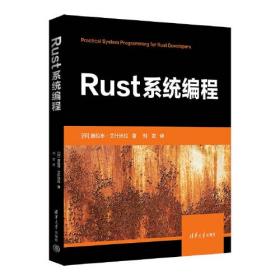
Rust编程
¥ 34.18 2.9折 ¥ 118 九五品
仅1件
作者(美)吉姆·布兰迪(Jim Blandy),(美)詹森·奥兰
出版社东南大学出版社
ISBN9787564177331
出版时间2018-07
版次1
装帧平装
开本16开
纸张胶版纸
页数598页
字数99999千字
定价118元
上书时间2024-12-03
- 最新上架
商品详情
- 品相描述:九五品
- 商品描述
-
基本信息
书名:Rust编程
定价:118.00元
作者:(美)吉姆·布兰迪(Jim Blandy),(美)詹森·奥兰多夫(Jason Orendorff) 著
出版社:东南大学出版社
出版日期:2018-07-01
ISBN:9787564177331
字数:764000
页码:598
版次:1
装帧:平装
开本:16开
商品重量:
编辑推荐
内容提要
Rust是一种新的系统编程语言,兼具C和C++的性能与底层控制,以及内存安全与线程安全。Rust的现代和灵活类型保证你的程序没有间接引用空指针、重复释放、迷途指针以及类似bug,都在编译时态,没有运行时开销。在多线程代码中,Rust在编译时捕获数据竞争,使得并行更易于使用。 《Rust编程( 英文版)》由两位富有经验的系统程序员吉姆·布兰迪、詹森·奥兰多夫撰写,介绍了Ru5t如何兼顾性能和安全,以及怎样才能利用这个特性。
目录
Preface1. Why Rust?Type Safety2. A Tour of RustDownloading and Installing RustA Simple FunctionWriting and Running Unit TestsHandling Command-Line ArgumentsA Simple Web ServerConcurrencyWhat the Mandelbrot Set Actually IsParsing Pair Command-Line ArgumentsMapping from Pixels to Complex NumbersPlotting the SetWriting Image FilesA Concurrent Mandelbrot ProgramRunning the Mandelbrot PlotterSafety Is Invisible3. Basic TvpesMachine TypesInteger TypesFloating-Point TypesThe bool TypeCharactersTuplesPointer TypesReferencesBoxesRaw PointersArrays, Vectors, and SlicesArraysVectorsBuilding Vectors Element by ElementSlicesString TypesString LiteralsByte StringsStrings in MemoryStringUsing StringsOther String-Like TypesBeyond the Basics4. OwnershipOwnershipMovesMore Operations That MoveMoves and Control FlowMoves and Indexed ContentCopy Types: The Exception to MovesRc and Arc: Shared Ownership5. ReferencesReferences as ValuesRust References Versus C++ ReferencesAssigning ReferencesReferences to ReferencesComparing ReferencesReferences Are Never NullBorrowing References to Arbitrary ExpressionsReferences to Slices and Trait ObjectsReference SafetyBorrowing a Local VariableReceiving References as ParametersPassing References as ArgumentsReturning ReferencesStructs Containing References6. Expressions7. Error Handing8. Crates and modules9. Structs10. Enums and patterns11. Traits and generics12. Operator overloading13. Utility traits14 Cloures15. Iterators16. Collections17. Strings and text18. Input and Output19. Concurrency20. Nacros21. Unsafe codeIndex
作者介绍
序言
-

【封面】
相关推荐
— 没有更多了 —













以下为对购买帮助不大的评价